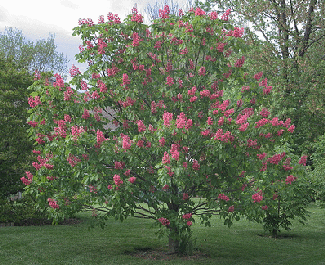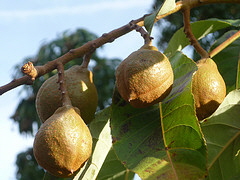Horse Chestnut Trees
Aesculus hippocastanum Common Horse Chestnut
Zones: 3-7
Sun: Full sun to part shade
Height: 50-75’, up to 100’
Spread: 40-60’
Shape: Upright oval or domed dense crown, outer branches often droop and have curled up tips
Growth Rate: Moderate
Soil Preference: Prefers moist well drained, cultivated soil. Fairly adaptable but does not like soggy soil.
Moisture: Average moisture requirements, somewhat drought tolerant
Foliage: Light green in spring maturing dark green, 7 leaflet, coarse texture. Turns yellow or brown in Fall
Blooms: 5-12” erect, full clusters of white flowers with tiny red spots, late spring
Fruit: 2 - 2 1/2” round, green to light brown, very spiny capsules in fall, slightly poisonous
The Common Horse Chestnut leafs out early in spring with light green leaves. The blooms in early spring are spectacular, peaking by mid May. After the leaves have fallen, a very attractive branching form is exposed, with spreading branches turned up at the ends. The wood tends to be soft and weak, sometimes breaking limbs under the weight of heavy snow. Prune crossed or wayward interior branches to encourage a strong structure. Horse Chestnut bleeds extensively and should be pruned midsummer after new growth has matured and bloom period is done. Common Horse Chestnut is very susceptible to leaf scorch and should not be planted in hot, dry, windy sites to minimize the problem. The tree will be healthiest in cool climates. Very tolerant of urban air pollution, somewhat tolerant of aerosol salt doing quite well in coastal environments. Flowers attract bees.
Aesculus hippocastanum ‘Baumannii’ ‘Baumannii’ Horse Chestnut
Zones: 3-8
Sun: Full sun to part shade
Height: 50-75’, up to 100’
Spread: 30-60’
Shape: Upright oval to rounded crown, outer branches often droop.
Growth Rate: Slow to moderate
Soil Preference: Prefers moist well drained, cultivated soil. Fairly adaptable.
Moisture: Average moisture requirements, somewhat drought tolerant
Foliage: Light green in spring maturing dark green, 7 leaflet, coarse texture. Turns yellow or brown in Fall
Blooms: 5-12” erect, full clusters of double white flowers with tiny red spots, late spring
Fruit: None
The ‘Baumannii’ variety of Common Horse Chestnut delivers two big improvements. The double flowers are impressive and last longer than the single, blooming a bit later than Common Horse Chestnut. And NO fruit is produced! No big conkers littering the lawn is a big plus. It is also a bit taller and not quite as wide. ‘Baumannii’ develops a tap root so it very difficult to move once established. The wood tends to be soft and weak, sometimes breaking limbs under the weight of heavy snow. Prune crossed or wayward interior branches to encourage a strong structure. Horse Chestnut bleeds extensively and should be pruned midsummer after new growth has matured and bloom period is done. It is also very urban tolerant, somewhat drought and salt tolerant, and makes an excellent boulevard or specimen tree.
Aesculus x carnea Red Horse Chestnut
Zones: 4-8
Sun: Full sun to part shade
Height: 30-45’
Spread: 30-45’
Shape: Pyramid when young, broad rounded crown as it matures
Growth Rate: Slow to moderate
Soil Preference: Prefers moist, fertile, well drained, acidic soil. Tolerates average soil.
Moisture: Average moisture requirements, somewhat drought tolerant
Foliage: Dark green, 5 leaflet, coarse texture. Turns brown in October
Blooms: 5-8” erect, full clusters of red flowers late spring
Fruit: 1-1/12” round, light brown, prickly capsules in fall
The Red Horse Chestnut is a hybrid between the common horse chestnut and the red buckeye. Carnea is more drought tolerant and more resistant to leaf scorch and mildew than the common horse chestnut, with a bit more rounded growth habit. The crown is broad and symmetrical, making an excellent specimen or boulevard tree. It may take up to ten years for a Red Horse Chestnut to bloom. The blooms attract bees and hummingbirds. The fruits attract squirrels.
Red Horse Chestnut branches tend to grow downward or droop as they mature, pruning of lower branches may be necessary to allow clearance. The wood tends to be soft and weak, sometimes breaking limbs under the weight of heavy snow. Prune crossed or wayward interior branches to encourage a strong structure. Horse Chestnut bleeds extensively and should be pruned midsummer after new growth has matured and bloom period is done. Trunk bark may crack if exposed to direct sun, or winter sun in the north. Allowing the drooping branches to shade the trunk solves the summer problem, trunk wrap in winter in the north. Red Horse Chestnut is moderately tolerant of soil and aerosol salt.
Aesculus x carnea ‘Briotii’ Ruby Red Horse Chestnut
Zones: 5-8
Sun: Full sun to part shade
Height: 25-35’
Spread: 25-35’
Shape: Oval to rounded crown
Growth Rate: Moderate
Soil Preference: Prefers moist, fertile, well drained soil, will tolerate average soil.
Moisture: Average moisture requirements
Foliage: Dark green, 5 leaflet, coarse texture. Turns brown in October
Blooms: 8-10” erect, full clusters of deep red flowers in May
Fruit: 1 1/2” round, prickly, poisonous
Ruby Red Horsechestnut is a bit smaller than Red Horse Chestnut. The flower clusters are a deep red and larger than the species. It is less susceptible to fungal disease. Dry conditions may cause leaf scorch and a general decline in the tree’s health, so make sure it receives adequate moisture in dry periods. ‘Briotii” develops a tap root so it very difficult to move once established. The wood tends to be soft and weak, sometimes breaking limbs under the weight of heavy snow. Prune crossed or wayward interior branches to encourage a strong structure. Horse Chestnut bleeds extensively and should be pruned midsummer after new growth has matured and bloom period is done. A very popular cultivar of Aesculus.
Aesculus indica Indian Horse Chestnut
Zones: 7-9a
Sun: Full sun
Height: 40-60’, up to 100’
Spread: 35-50’
Shape: Upright rounded dense crown, outer branches often droop.
Growth Rate: Moderate
Soil Preference: Prefers moist well drained soil. Fairly adaptable.
Moisture: Average moisture requirements, somewhat drought tolerant
Foliage: Very large 9” green leaves, 7 leaflet, coarse texture. Turns orange in Fall
Blooms: 4-6” erect, full upright clusters of white with pink flowers in spring into summer.
Fruit: 1-3” round, smooth brown and green capsules maturing in October and persisting in winter.
The showy white blooms of Indian Horse Chestnut are at least 6” long on upright panicles, with over 300 tiny flowers each. The bloom spikes appear in April, opening in May into June, after most trees and shrubs have finished flowering. Not only does this extend blooming in the landscape, but is ideal to encourage insect pollination of the tree with scarce other blooms for the bees. The fruit, or nut, is produced in huge quantities. The very large leaves are quite attractive, opening in very early spring. Indian Horse Chestnut is fairly adaptable, tolerating clay or sand and slightly alkaline or acidic soil. Does not tolerate aerosol salt well. The wood tends to be somewhat soft and weak, Prune crossed or wayward interior branches to encourage a strong structure. Horse Chestnut bleeds extensively and should be pruned midsummer after new growth has matured and bloom period is done.








